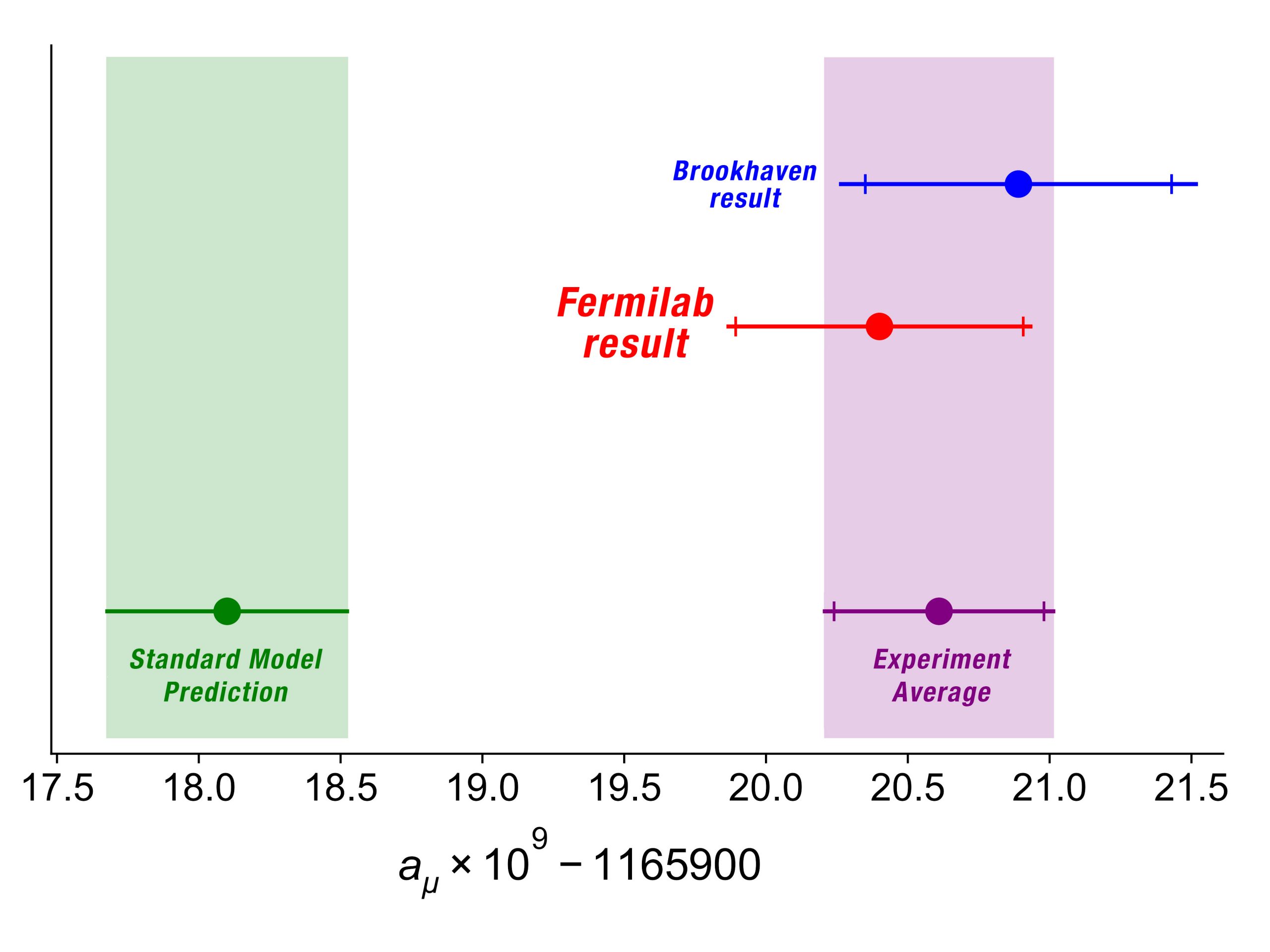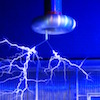Friday Flyer - April 9, 2021
The Friday Flyer comes out every other week. Look for the next issue on April 23.

Spotlight on g-2
The physics buzz since Wednesday has been all about the announced results of the g-2 experiment at Fermilab for two important reasons. First, they were long-awitied since the results of the g-2 experiment at Brookhaven, very much the parent to the Fermilab effort. Second, it is the actual result, which is, well, striking.
"Wait!" you might exclaim, adding, "What is g-2, aside from 7.81 m/s2, and why is it important?" Well, it is a different g. This g is the muon magnetic moment, which describes how the angular momentum vector of a muon precesses in a magnetic field. And this g is two-point-something. If the muon were totally alone, it would be just g=2 and we'd be done. However, Standard Model virtual interactions correct the number to a little more than 2. If you want to test the Standard Model, you are only interested in the decimal, hence g-2.
And here's the thing: Brookhaven found that the decimal is not quite right for the Standard Model. When the experiment was done, it was shipped off to Fermilab to be upgraded to the latest tech and run again at four times the precision. We now, as of Wednesday, have the Run I result from Fermilab and it so far confirms the Brookhaven result to a new confidence level of 4.2σ. Remember, 5σ is discovery level.
If the result holds up and we get to 5σ after analysis of Run II and III data (the experiment is in Run IV now), it would mean that there is physics outside the Standard Model that is contributing to that corrective decimal. New physics.
There is more to learn about g-2 and other interesting physics results, and you will find the opportunities in the sections below.

Masterclass fans: Note the importance of combined results!

News from QuarkNet Central
FF has learned of two virtual special events—one at Fermilab and one at Brookhaven Lab—on the g-2 results. At Fermilab, there will be a public lecture on April 17, What Can Wobbling Muons Tell Us About the Particles in Our Universe? by Dr. Adam Lyon. Together with Brookhaven Lab, the African School of Fundamental Physics and Applications (ASP) will present an online seminar, A Precision Measurement of the Anomalous Magnetic Moment of the Muon, by Dr. William Morse. Both events are free, but you must register. The BNL/ASP event is more at university level and not appropriate for high school students.
Our next QuarkNet Educational Discussions (QED) will have a special meeting for U.S. and Italian physics teachers to discuss common problems this coming Monday morning. Read about it in the QED Special Edition flyer and then register to join in. The last QED of the 2020–21 academic year will take place on Wednesday, April 21, with a planned talk on the exploration of the moon Titan.
What is World Quantum Day? Well, it is next week, on Wednesday, April 14. And, learn more!
Another STEP UP opportunity: Teachers may apply to become a STEP UP Advοcate, one of a special group of 200+ teachers who will be provided professional development and community support in order to implement the STEP UP lessons. Advοcates may earn a stipend up to $400. The application deadline has been extended to April 9.
Beamline for Schools 2021 is still on, but not for long! Get basic information and a registration link in the announcement, and find more resources at the Useful Documents page. The deadline is April 15.
INSPYRE (INternational School on modern PhYsics and REsearch) will host a series of lectures online on April 12–16, 2021. It seems that registration is still open. The European School Innovation Academy has a whole menu of summer science workshops and training courses. There is no fee, but you do have to get and keep yourself there on your own. And here are the latest offerings from Perimeter Institute.

Physics Experiment Roundup
Let's dig into the g-2 result first with some "go-to" articles: the press release in Interactions, the article in Fermilab News, and the article from BNL Newsroom. In the popular press, check A Tiny Particle’s Wobble Could Upend the Known Laws of Physics in the New York Times (H/T Marge Bardeen) and Muons: 'Strong' evidence found for a new force of nature from the BBC. And if you really want to dig in, here is the paper, Measurement of the Positive Muon Anomalous Magnetic Moment to 0.46 ppm, in Physical Review Letters.
Is that all the possible new physics? Not really. In our last issue we pointed to the LHCb (Large Hadron Collider beauty) experiment result that, if confirmed, would suggest a possible violation of lepton flavor universality. WBEZ Chicago ties this news to g-2 (thanks again, Marge) and the BBC reports further on the LHCb result. And, again, dig in further with the LHCb paper on the subject.
But wait! There's less! (Maybe.) We are not at 5σ yet for LHCb or g-2 results. Science 2.0 is skeptical about LHCb and Forbes expresses caution on g-2.
But wait! There's more! The CERN AMS experiment on the International Space Station has recent results of its own, pointing to a possible dark matter signal deep in space, as reported in Science Times, and, from CERN Bulletin, finding unusual properties of iron nuclei as primary cosmic rays. Here is the AMS iron nuclei paper in Physical Review Letters. The MeerKAT radio telescope array in South Africa has discovered "radio bubbles" at the galactic center, according to the African Physics Newsletter. And high in Tibet, the Tibet ASγ experiment sees Signs of PeVatrons in Gamma-Ray Haze (astrophysical phenomoena that accelerate particles to the peta-electron-volt (1015 eV or 100 times the LHC) the level of energy, according to APS Physics.

Resources
The film festival continues from the March 26 FF with the latest: this short gem about g-2 and then, to learn more, the Fermlab press conference and scientific seminar. We also have a nice and brief video on the LHCb result. Earlier videos, How Particle Physics Works and How Particle Physics Works Episode II from ETH Zurich, go deeper into the questions.(Note that they were made before the LHCb announcement but anticipated it.)
For good reads, symmetry explains g-2 (prior to the announcement) and how a degree in physics can lead to a data science career. And Fermilab News rounds it out with the search for supersymmetry.

Just for Fun
Science in the middle ages does not always get a good rap in these modern times but, back then, those were modern times. Physics Today has an interesting article, Medieval Weather Prediction, that explains what folks back then did learn and how it has been passed to present-day meteorology. And the forecast? Rainy with a chance of dragons, of course.
April Fools Day came and went since our last issue. Here is the prairie-dweller contribution from Fermi News.
If you like molten rock or have a ring of power you need to destroy, there is nothing like a volcano. Here's one, active right now in Iceland. It may be way hot, but the footage is way cool, and another H/T to Marge Bardeen. A 3-fer, Marge!
QuarkNet Staff:
Mark Adams: adams@fnal.gov
Ken Cecire: kcecire@nd.edu
Spencer Pasero: spasero@fnal.gov
Shane Wood: swood5@nd.edu
